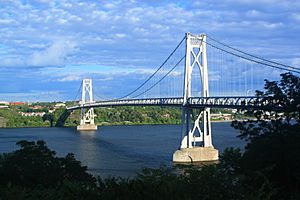Mid-Hudson Bridge facts for kids
Quick facts for kids Mid-Hudson Bridge |
|
|---|---|
 |
|
| Coordinates | 41°42′11″N 73°56′46″W / 41.70306°N 73.94611°W |
| Carries | 3 lanes of |
| Crosses | Hudson River |
| Locale | Highland, New York and Poughkeepsie, New York |
| Official name | Franklin Delano Roosevelt Mid-Hudson Bridge |
| Maintained by | New York State Bridge Authority |
| Characteristics | |
| Design | Suspension bridge |
| Total length | 3,000 feet (910 m) |
| Longest span | 1,500 feet (460 m) |
| Clearance above | 135 feet (41 m) |
| History | |
| Opened | August 25, 1930 |
| Statistics | |
| Toll | (eastbound only) passenger cars $1.75 cash, $1.35 E-ZPass |
The Franklin Delano Roosevelt Mid-Hudson Bridge is a special kind of toll suspension bridge. It helps US 44 and NY 55 cross the Hudson River. This bridge connects the towns of Poughkeepsie and Highland in New York State.
Contents
History of the Mid-Hudson Bridge
Building a Bridge Across the Hudson
People started talking about building a bridge over the Hudson River in 1923. At that time, there were no main highway crossings south of Albany. Even though other big projects like the Bear Mountain Bridge were being built, a new bridge was still needed.
The Governor at the time, Alfred E. Smith, signed a bill in June 1923 to start the project. The New York State Department of Public Works was in charge of building it. This department is now called the New York State Department of Transportation.
Construction Begins
Construction on the Mid-Hudson Bridge began in 1925. Workers had to sink huge concrete boxes, called caissons, into the riverbed. These caissons weighed 66,000 tons! Crews worked in special pressurized areas to remove dirt from the river bottom.
The tall, Gothic-style steel towers of the bridge were built in April 1929. They stand about 315 feet (96 meters) high. The bridge officially opened on August 25, 1930.
New Ownership and Tolls
Just three years after it opened, in 1933, the bridge's ownership changed. It was given to the New York State Bridge Authority. This group was created to manage bridges in New York.
The opening ceremony was a big event. Then-Governor Franklin D. Roosevelt and his wife Eleanor were there. The bridge was later renamed the "Franklin Delano Roosevelt Mid-Hudson Bridge" in 1994, honoring the former governor.
Changes to Toll Collection
The place where tolls were collected used to be on the Poughkeepsie side of the bridge. But in December 1967, it was moved to the Highland side. This happened when a new road was built to connect to the bridge.
At first, drivers paid tolls when going in both directions. However, in August 1970, things changed. Westbound drivers no longer paid a toll. Instead, eastbound drivers had their tolls doubled. This change happened for many other bridges over the Hudson River at the same time.
The Bridge as a Musical Instrument
In 2009, a composer named Joseph Bertolozzi created a unique project called Bridge Music. He found a way to "play" the Mid-Hudson Bridge like a giant musical instrument! This project was part of New York's 400th anniversary celebration of Henry Hudson's journey up the Hudson River.
Bertolozzi's idea was very bold and got a lot of attention around the world. He recorded the sounds he made using the bridge itself. His "Bridge Music" CD even made it onto the Billboard Classical Crossover Music Chart.
About the Mid-Hudson Bridge
Bridge Design and Size
The Mid-Hudson Bridge is 3,000 feet (914 meters) long. It stands 135 feet (41 meters) above the Hudson River, allowing boats to pass underneath. When it first opened, it was the sixth-longest suspension bridge in the world.
The main engineer for the bridge was Ralph Modjeski. He was an immigrant from Poland. He also helped make the nearby Poughkeepsie Railroad bridge stronger. The American Bridge Company built the bridge, using steel from Carnegie. The bridge has special support structures called trusses that are built on top of the bridge deck.
Traffic and Lanes
The bridge carries three lanes of traffic for US 44 and NY 55. It also has a walkway for people who want to walk or bike across. The bridge connects to US 9 on the east side and US 9W on the west side.
Usually, the middle lane of the bridge is closed. However, it opens during busy times. It's open for eastbound traffic from 6 AM to 9 AM and for westbound traffic from 3 PM to 6 PM. Sometimes, the middle lane also opens when workers are doing maintenance on the bridge.
There are five special signals, called "gantries," that show which lanes are open for travel. The roads leading to the bridge have four lanes, but the bridge itself only has one or two lanes open. This can sometimes cause a traffic bottleneck, where traffic slows down.
Decorative Lighting and Tolls
The Mid-Hudson Bridge has a cool computer-controlled lighting system. It uses LED lights attached to the suspension cables. This allows the bridge to be lit up in different colors for holidays. For example, it can be red and green for Christmas or red, white, and blue for the Fourth of July.
As of May 2020, the toll for passenger cars going eastbound on the Mid-Hudson Bridge was $1.75 if you paid with cash. If you used an E-ZPass, the toll was $1.35.
Images for kids
-
The bridge from the north, as seen from the Walkway Over the Hudson







